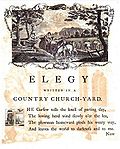
Elegy Written in a Country Churchyard is a poem by Thomas Gray, completed in 1750 and first published in 1751. The poem’s origins are unknown, but it was partly inspired by Gray’s thoughts following the death of the poet Richard West in 1742. Originally titled Stanza's Wrote in a Country Church-Yard, the poem was completed when Gray was living near St Giles' parish church at Stoke Poges. It was sent to his friend Horace Walpole, who popularised the poem among London literary circles. Gray was eventually forced to publish the work on 15 February 1751, to pre-empt a magazine publisher from printing an unlicensed copy of the poem.
The poem is an elegy in name but not in form; it employs a style similar to that of contemporary odes, but it embodies a meditation on death, and remembrance after death. The poem argues that the remembrance can be good and bad, and the narrator finds comfort in pondering the lives of the obscure rustics buried in the churchyard. The two versions of the poem, Stanzas and Elegy, approach death differently; the first contains a stoic response to death, but the final version contains an epitaph which serves to repress the narrator's fear of dying. With its discussion of, and focus on, the obscure and the known, the poem has possible political ramifications, but it does not make any definite claims on politics to be more universal in its approach to life and death.
The poem quickly became popular. It was printed many times, translated into many languages, and praised by critics even after Gray's other poetry had fallen out of favour. Later critics tended to praise its language and universal aspects, but some felt the ending was unconvincing, failing to resolve the questions the poem raised; or that the poem did not do enough to present a political statement that would serve to help the obscure rustic poor who form its central image. (Full article...)